Eduard 1/32 Bf-109E-4
|
KIT #: |
3003 |
|
PRICE: |
$74.95 SRP |
|
DECALS: |
Five options |
|
REVIEWER: |
Tom Cleaver |
|
NOTES: |
Squadron/Falcon vacuform canopy,
Quickboost exhausts & resin main wheels used. |
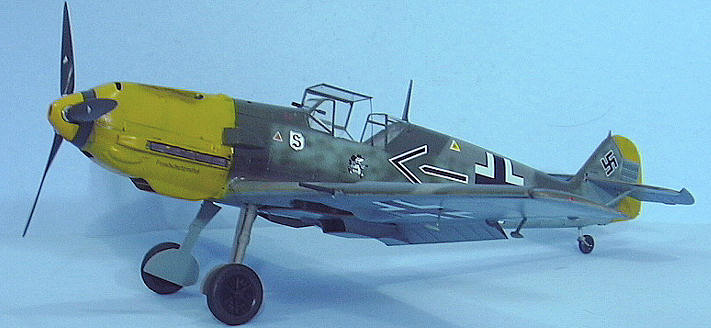
Virtually indistinguishable from the Bf-109E-3 (aside from the more
robust canopy that was often retro-fitted to earlier aircraft. Ed), the
Bf-109E-4 was equipped with the MG FF(M) cannon, which could fire explosive
rounds (“Minengeschloss”) that were far more lethal to an enemy aircraft, since
one hit was enough to break off a wing or shatter a fuselage.
The Bf-109E-4 began to appear in the Jagdwaffe in late July, 1940, and
fought alongside the Bf-109E-1/3 throughout the campaign.
Adolf Galland:
Adolf Galland was born in Westerholt, Westphalia, on March 19, 1912 the
second of four sons, two of which also became fighter pilots and aces before
being killed in combat: Paul Galland was killed on October 31, 1942 when he was
shot down by a Spitfire after scoring 17 victories, while Wilhelm-Ferdinand
Galland was shot down and killed on August 17, 1943 after scoring 54 victories.
Adolf was interested as a child by the airplanes he saw during the First
World War; during the 1920s, he flew gliders as part of the national sport
aviation movement. After graduating
from the Hindenburg Gymnasium in 1932, he was among 20 applicants
accepted to the Lufthansa flying school.
Galland joined the technically illegal Luftwaffe in 1933.
Following a training crash in which he suffered a damaged eye, fractured skull
and broken nose, he was in a coma for three days.
A second crash a year later aggravated his injured eye and he was only
allowed to continue training after passing an eye test, which he memorized.
Following completion of training in
Italy
in 1935, he was posted to JG 132 “Richthofen,” based at Döberitz near
Berlin.
Galland was among the first Luftwaffe pilots sent to
Spain
in 1937, where he was appointed Staffelkapitän of 3.J/88.
Following the discovery that the He-51 was unable to fight against the
I-15 or I-16, Galland flew 300 ground attack missions, and he became known as a
ground attack specialist for his development of tactics and weapons such as
gasoline and oil bombs that were the precursors of napalm.
It was in Spain that Galland first displayed his dashing style, flying in
swimming trunks with a cigar between his teeth, in an aircraft decorat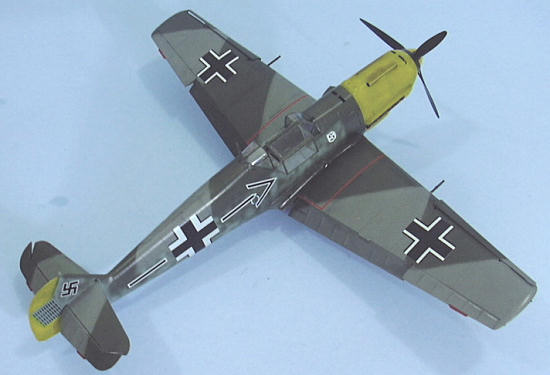 ed
with a Mickey Mouse figure which later became the symbol of the
Schlachtflieger.
ed
with a Mickey Mouse figure which later became the symbol of the
Schlachtflieger.
Promoted to Hauptmann just prior to the outbreak of World War II,
Galland became Staffelkapitän of 4.(S)/Lehrgeschwader 2, equipped
with the Henschel Hs-123, He flew an average of four sorties a day during the
Polish campaign and was awarded the Iron Cross Second Class.
Prevented from joining the Jagdwaffe on the grounds he was too
experienced in ground attack, Galland falsely claimed he had rheumatism and was
removed from his post on medical grounds.
In February 1940 he was posted to Jagdgeschwader 27 as adjutant
and restricted from flying, forcing him to sneak away to fly combat missions.
Galland scored his first victories over
Liege
on
May 12, 1940,
shooting down three RAF Hurricanes. By the end of the French campaign, Galland
had scored 14 victories and became the third fighter pilot to receive the
Knight's Cross of the Iron Cross on August 1, 1940.
Just before the end of the French campaign, Galland joined the unit with
whom he would become synonymous, when he was assigned as Gruppenkommandeur
of
III./Jagdgeschwader
26 “Schlageter.” That July, he was
promoted t o Major at the outbreak of the
Battle
of
Britain.
By mid-August, Luftwaffe commander Reichsmarschall Hermann Göring's
dissatisfaction with the Jagdwaffe’s performance led him to replace his
pre-war Jagdgeschwader Kommodores with younger high-achievers.
Galland replaced Major Gotthard Handrick as Geschwader Kommodore of JG 26
on August 22. After scoring 40
kills by September 25, Galland was awarded the Eichenlaub to the
Ritterkreuz.
Mythology has it that during the
Battle
of
Britain,
in a briefing on Luftwaffe tactics, Göring asked what was needed to win. Werner
Mölders replied that the Bf-109 should be fitted with more powerful engines.
Galland is said to have replied: "I should like an outfit of Spitfires for my
squadron," which left Göring speechless with rage.
The truth is that Galland never said this, though he did tell Göring that
the Spitfire was better in its role as a defensive interceptor than the Bf-109
was in the role it was forced to fly in as a defensive escort rather than as a
free-ranging hunter.
There was much controversy during the
Battle
of
Britain
over killing parachuting enemy pilots, since they could then live to fight
another day. In another
confrontation with Göring, Galland recalled: “Göring wanted to know if we had
ever thought about this. ‘Jawohl, Herr Reichsmarschall!’ He looked me straight
in the eyes and said, ‘What would you think of an order to shoot down pilots who
were bailing out?’ ‘I should regard it as murder, Herr Reichsmarschall, and I
should do everything in my power to disobey such an order.’ The Reichsmarschall
replied ‘That is just the reply I had expected from you, Galland.’"
By December 1940, Galland had 58 victories and was promoted to
Oberstleutnant. By April 1941, most of the Jagdwaffe had been withdrawn from
the Channel Front, leaving JG 26 and JG 2 as the only single-engine fighter
Geschwader in
France.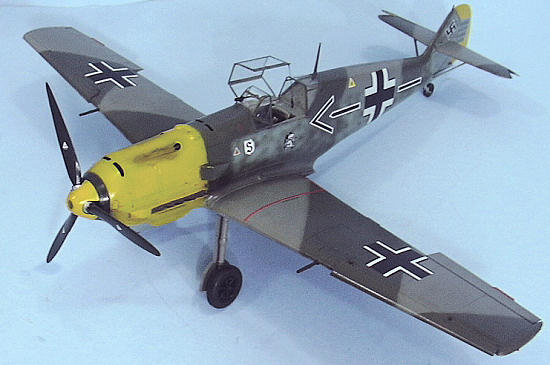
At this time, JG 26 began to re-equip with the new Bf-109F, which was
equipped with a single 20 mm cannon firing through the propeller hub and two
cowl-mounted 7.9 mm MG 17. While Mölders approved of this, Galland felt it was a
retrograde development because the average fighter pilot needed the additional
weight of fire in combat. Galland
continued to fly his Bf-109E-4 until he received two special Bf-109Fs - one with
a unique armament of an MG 151/20 cannon and two cowl-mounted 13 mm MG 131s,
with the other equipped with integral wing-mounted 20 mm MG-FF cannons and
cowl-mounted MG 17s. (In the
late 1960s and early 1970s, the scale model experten believed Galland had one
airplane, equipped with the engine mounted cannon, 13mm machine guns, and
wing-mounted cannon. Thomas
Hitchcock disproved this by publishing photos of both airplanes in his “109
Gallery”.)
As the RAF began what was called the “Non-Stop Offensive” over
northwestern
France,
Galland's careful leadership and astute tactical awareness kept JG 26's losses
to a minimum while inflicting maximum damage on the RAF throughout 1941. This
superiority became even greater as I/JG 26 began to convert to the Focke-Wulf Fw
190A beginning that September, an aircraft which completely outclassed the
Spitfire Mark Vb.
On
April 15, 1941
Galland set off to a birthday party for General Theo Osterkamp at La Touquet
that soon became his most memorable mission. He detoured towards
England
to see if there was any action and discovered a group of Spitfires commanded by
RAF ace Brendan “Paddy” Finucane over the Cliffs of
Dover.
Galland dove to the attack and quickly shot down three Spitfires.
Finucane got behind him and riddled the new Bf 109F. Galland’s attempt to
bail out as he crossed into
France
was nearly fatal when his parachute caught on the radio mast behind the cockpit.
When he managed to pull himself loose, he was so low he only swung twice
before hitting the ground.
On the morning of
June
21, 1941,
Galland was shot up by a Spitfire from the Polish 303 Squadron and crash landed.
That afternoon, he was shot down by
a Spitfire from 145 Squadron,
suffering slight injuries when he bailed out. Arriving back at the base that
evening, he found he had become the first member of the Wehrmacht to be
awarded the Schwerter to the Ritterkreuz for his 70th victory.
Galland had always flown without the extensive head armor found on the
Bf-109, which he believed was not worth the increased protection due to the fact
it restricted rear vision so badly.
On
July 2, 1941,
with his own fighter being repaired, he led JG 26 into combat against a
formation of Blenheims in another aircraft. A Spitfire from 308 Squadron hit
Galland's plane with a 20 mm shell in the rear of the canopy, and his life was
saved by the armor plate. After
that, he finally equipped his own airplane with the head armor.
Shortly after scoring his 94th victory, Galland was appointed General
der Jagdflieger by Hermann Göring, to succeed Werner Mölders, who had just
died in an air crash while en route to the funeral of Ernst Udet. Galland was
not enthusiastic about this, since he saw himself as a combat leader and did not
want to be tied to a desk job. One of his first assignments was to organize the
successful air protection for “The Channel Dash” - the breakout of the battle
cruisers Scharnhorst and Gneisenau and the cruiser Prinz Eugen
from
Brest
to
Kiel
in February 1942. In November 1942, his promotion to Generalmajor made
Galland the youngest officer to attain General rank in
Germany
and he was put in charge of organizing the day fighter defense of
Germany
against the Eighth Air Force. In order to experience the operational conditions
under which his pilots flew, Galland flew a dozen
combat missions between 1942–44 and probably gained two more victories
over B-17 Flying Fortresses in early 1944, On one occasion, flying with Hannes
Trautloft, h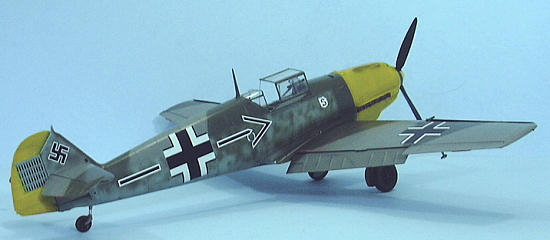 e
narrowly avoided being shot down by the American escort.
e
narrowly avoided being shot down by the American escort.
Galland’s 104 victories included seven scored with the Me 262. His claims
for aircraft destroyed include 55 Spitfires, 30 Hurricanes, and 5 French Armee
de l'Air aircraft. All seven of his Me 262 kills were against American aircraft,
two of them heavy bombers.
In the late 1970s, a
San
Jose
State
University
graduate student read Galland's memoir, The First and the Last, while
researching
United
States
Army Air Force records and matching them to German claims. He found that James
Finnegan, a P-47 Thunderbolt pilot of the 50th Fighter Group, Ninth
US
Army Air Force, made a "probable" claim for an Me-262 on
April 26, 1945,
the day of Galland’s last mission. The details were matched, and the two met for
the first time at an Air Force Association meeting in
San
Francisco
in 1979.
Galland was captured by the
United
States
Army on
May 14, 1945
and was a POW until 1947. After his
release, he lectured on tactics for the Royal Air Force. He moved to Argentine
in 1948, remaining until the fall
of Juan Peron in 1955, during which time he and other ex-Luftwaffe experts
worked as consultants to the Argentine Air Force and the nascent Argentine
aircraft industry. Returning to
Germany,
Galland had a successful career as an aviation consultant. During this time he
built lasting friendships with many of his former adversaries, particularly
Robert Stanford Tuck, Johnnie Johnson, and Douglas Bader.
In 1966-67, he served as a historical and technical consultant in the
making of the film “The
Battle
of
Britain.”
In 1973, he was a significant on-screen contributor to the British
television documentary series “The World at War.”
Adolf Galland died on February 9, 1996.
In May 1984, I had the rare privilege of meeting General Galland at that
year’s convention of the American Fighter Aces Association in
Phoenix.
With Chuck Yeager and Robert L. Scott, Jr. proclaiming my bonafides as an
aviation writer, I was able to talk with the General for a few hours that
weekend. Even at age 72, he was
still the charismatic leader who commanded the respect of everyone.
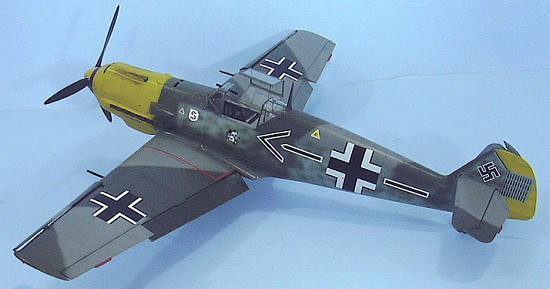 Eduard’s long-awaited Bf-109E-4 is the second in a line of completely-new
kits of the Bf-109E - best-known sub-type of
Germany’s
most famous fighter of the Second World War.
The kit provides 169 parts in olive colored plastic, with five clear
parts, two photo-etched frets including one in color, canopy masks, and markings
for five aircraft plus full stencil data.
Eduard’s long-awaited Bf-109E-4 is the second in a line of completely-new
kits of the Bf-109E - best-known sub-type of
Germany’s
most famous fighter of the Second World War.
The kit provides 169 parts in olive colored plastic, with five clear
parts, two photo-etched frets including one in color, canopy masks, and markings
for five aircraft plus full stencil data.
The parts are crisply molded with fine recessed panel line detail and
rivets in various places where it is correct to see them.
Following the release of this kit, modelers noted that the canopy was
incorrect in cross section, being too narrow at the top.
The created something of a brew-ha-ha at The Other Place for a week or
so. The screaming and yelling
ceased after Eduard announced that they had indeed made a mistake with the
canopy, and would be issuing a corrected canopy in their coming release of the
Bf-109E-7 this fall. In the
meantime, modelers have found that the Squadron/Falcon vacuform canopy -
originally made to correct the earlier Hasegawa Bf-109E kit - fits the Eduard
kit and provides an accurate canopy.
Having used one of my two Cutting Edge resin cockpits on the
previously-released Bf-109E-1, I decided to use the last one on this model.
While this cockpit can be used and does fit easily, it is not really as
accurate as it appears, since it was made for the old Hasegawa kit and its many
inaccuracies; this is primarily seen with the rear cockpit bulkhead, which
slopes at a much
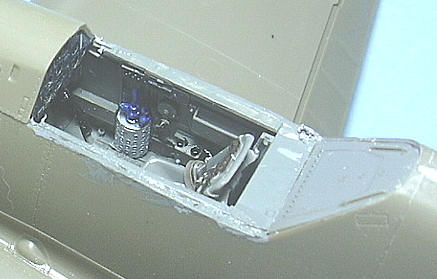 steeper
angle than is right. However, once
installed this is not at all obvious, and the final result is a busier cockpit
than what comes with the kit; the
seat - especially if you have the seat with the molded-in back pad and seat
belts - makes up into a much nicer-looking seat than what you can do with the
kit. Thus, a modeler who bought
that set from Cutting Edge can finally put it to use in this kit. This is not to
slam the kit cockpit, which can be turned into something really nice with only a
modicum of effort using the photoetch detail.
steeper
angle than is right. However, once
installed this is not at all obvious, and the final result is a busier cockpit
than what comes with the kit; the
seat - especially if you have the seat with the molded-in back pad and seat
belts - makes up into a much nicer-looking seat than what you can do with the
kit. Thus, a modeler who bought
that set from Cutting Edge can finally put it to use in this kit. This is not to
slam the kit cockpit, which can be turned into something really nice with only a
modicum of effort using the photoetch detail.
Assembly started with the cockpit, as they say.
I painted the Cutting Edge parts with Xtracrylix RLM02, and detailed
them. For the seat, I used
Xtracrylix RLM81 Braunviolett for the leather pad, and
Xtracrylix
Gulf
Armour Tan for the seatbelts, enhancing everything with a wash of Tamiya “smoke”
to pop out detail and then giving the parts a coat of Xtracrylix Flat Varnish.
I used as much of the Eduard photoetch as possible to enhance the nice
detail in the Cutting Edge cockpit, with the photoetch instrument panel and all
the various wires for the trim wheels and such. I only had to cut off the
locating pins on the fuselage halves for everything to fit perfectly.
I decided I didn’t want to do the engine, so I closed up the engine
cowling after inserting the Quickboost resin exhausts.
These are easier to use than the separate exhaust stubs provided by the
kit, and look better with their “hollow” exhausts.
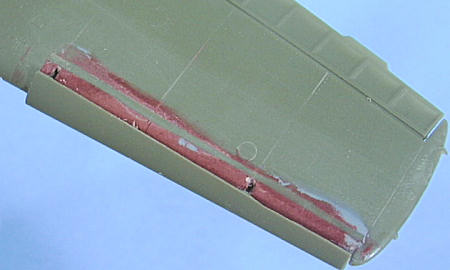 During the discussion about the incorrect canopy of this kit, another
modeler had questioned whether the wing leading edge slats were too wide in
chord, since they were about 1/16 inch wider than those on the 1/32 Hasegawa
Bf-109G kits, which have been considered highly accurate.
Another modeler pointed out that the real Bf-109 wing does not have the
“step” for the slats to fit in when closed, that the area is a smooth curve
underneath, as with all wings using Handley-Page slats.
Since correcting this seemed simple, I decided to do so.
I cut off the rear edge of each slat by 1/16 inch, then glued that into
the wing. I then filled the area
with Bondo spot putty, and sanded it into an airfoil shape.
I then rescribed and re-riveted the surface detail and finished off by
thinning the trailing edge of the slats to a “knife edge.”
During the discussion about the incorrect canopy of this kit, another
modeler had questioned whether the wing leading edge slats were too wide in
chord, since they were about 1/16 inch wider than those on the 1/32 Hasegawa
Bf-109G kits, which have been considered highly accurate.
Another modeler pointed out that the real Bf-109 wing does not have the
“step” for the slats to fit in when closed, that the area is a smooth curve
underneath, as with all wings using Handley-Page slats.
Since correcting this seemed simple, I decided to do so.
I cut off the rear edge of each slat by 1/16 inch, then glued that into
the wing. I then filled the area
with Bondo spot putty, and sanded it into an airfoil shape.
I then rescribed and re-riveted the surface detail and finished off by
thinning the trailing edge of the slats to a “knife edge.”
I then proceeded to assemble the rest of the model per instructions.
The instructions would have the wheel wells aluminum, but they should be
RLM02 with the walls of the wheel wells in leather brown, for which I used RLM81
“Braunviolett”. I used Xtracrylix
for these colors, popping out detail with Tamiya “Smoke.”
After attaching the slats, I left off the aileron mass balances for later
assembly, and attached the flaps in down position.
The horizontal stabilizers were assembled with the elevators drooped.
There had also been some note made of the fact that the landing gear legs
were at maximum extension, so I cut off the oleo legs and shortened them 1/16
inch to more accurately portray an airplane sitting loaded with fuel and
weapons.
Painting:
When Galland received this Bf-109E-4, the aircraft were coming out of the
factory in a camouflage scheme of RLM65 Hellblau lower surfaces, with an
upper “splinter” scheme of RLM02 Grau and RLM71 Dunkelgrun.
As Eduard’s instructions note, the airplane was repainted at various
periods in its career. What they
show is the airplane as it would have appeared at the end of
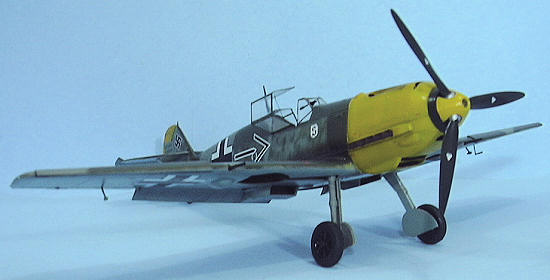 1940, with
the 68 victories on the rudder. I
had photos in the JG-26 “Top Guns of the Luftwaffe” photo book that showed the
airplane as it looked in late September at the time Galland scored his 40th
victory and was awarded the Eichenlaub to the Ritterkreuz.
I decided I would paint that scheme.
1940, with
the 68 victories on the rudder. I
had photos in the JG-26 “Top Guns of the Luftwaffe” photo book that showed the
airplane as it looked in late September at the time Galland scored his 40th
victory and was awarded the Eichenlaub to the Ritterkreuz.
I decided I would paint that scheme.
I first pre-shaded the model over the panel lines with flat black.
Then I painted the rudder and the engine cowling with RLM04 Gelb.
I masked off the yellow area of the rudder and the engine cowling, and then
pained the RLM 65 Hellblau. I
freehanded the upper camouflage, using a cardboard straightedge to get a
“harder” demarcation line.
The prop and the back plate were painted RLM70
Schwartzgrun. I then gave
the model a coat of Future.
One nice thing was that the Eduard canopy masks fit the Squadron/Falcon
canopy with only some minor modifications.
Decals:
The kit decals went on without a problem.
The decals provide two of the “Mickey Mouse” marking.
However, the accuracy of this was one of the questions I had asked
General Galland back in 1984, and he had told me it was only on the left side,
so I only applied it there.
I washed the model and then gave it a coat of Xtracrylix Flat Varnish,
which dries to a semi-matt finish that is accurate for well-maintained German
aircraft in the first half of the war, according to photos.
I applied exhaust and gunfire stains with Tamiya “Smoke.”
The landing gear was attached, with the resin main wheels taken from a
Promodeler Bf-109G-2/4 kit. As the
photos of the airplane at this time show it without head armor, I assembled the
canopy in the open position without head armor.
I finished off by attaching the aileron mass balances and the pitot tube.
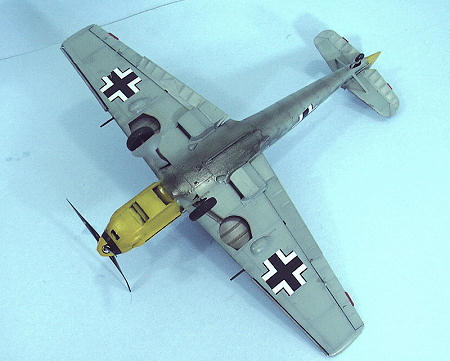 The Eduard kit, whether you use the various extras I did or not, is head
and shoulders above the competition in this scale.
Comparing this model to the Bf-109E-1 that was done out of the box other
than for the cockpit, the “sit” of the two is only slightly different and only
apparent when they are nose to nose.
Side by side, the difference of the slats is not that apparent just by
eyeballing things. A true “109 nut”
will want to do all this - none of which is difficult - while those not so
inclined can still have a good-looking model without the extra effort.
I do highly recommend the vacuform canopy, because the dimensional
mistake of the kit-supplied canopy really is obvious and does change the “look”
of the finished model.
The Eduard kit, whether you use the various extras I did or not, is head
and shoulders above the competition in this scale.
Comparing this model to the Bf-109E-1 that was done out of the box other
than for the cockpit, the “sit” of the two is only slightly different and only
apparent when they are nose to nose.
Side by side, the difference of the slats is not that apparent just by
eyeballing things. A true “109 nut”
will want to do all this - none of which is difficult - while those not so
inclined can still have a good-looking model without the extra effort.
I do highly recommend the vacuform canopy, because the dimensional
mistake of the kit-supplied canopy really is obvious and does change the “look”
of the finished model.
Thanks to Eduard for the review
kit. Thanks to Quickboost for the
review items.
Tom Cleaver
July 2009
Copyright ModelingMadness.com
If you would like your product reviewed fairly and fairly quickly, please
contact
the editor or see other details in the
Note to
Contributors.
Back to the Main Page
Back to the Review
Index Page 2020


 ed
with a Mickey Mouse figure which later became the symbol of the
Schlachtflieger.
ed
with a Mickey Mouse figure which later became the symbol of the
Schlachtflieger.

 Eduard’s long-awaited Bf-109E-4 is the second in a line of completely-new
kits of the Bf-109E - best-known sub-type of
Eduard’s long-awaited Bf-109E-4 is the second in a line of completely-new
kits of the Bf-109E - best-known sub-type of  steeper
angle than is right. However, once
installed this is not at all obvious, and the final result is a busier cockpit
than what comes with the kit; the
seat - especially if you have the seat with the molded-in back pad and seat
belts - makes up into a much nicer-looking seat than what you can do with the
kit. Thus, a modeler who bought
that set from Cutting Edge can finally put it to use in this kit. This is not to
slam the kit cockpit, which can be turned into something really nice with only a
modicum of effort using the photoetch detail.
steeper
angle than is right. However, once
installed this is not at all obvious, and the final result is a busier cockpit
than what comes with the kit; the
seat - especially if you have the seat with the molded-in back pad and seat
belts - makes up into a much nicer-looking seat than what you can do with the
kit. Thus, a modeler who bought
that set from Cutting Edge can finally put it to use in this kit. This is not to
slam the kit cockpit, which can be turned into something really nice with only a
modicum of effort using the photoetch detail.
 1940, with
the 68 victories on the rudder. I
had photos in the JG-26 “Top Guns of the Luftwaffe” photo book that showed the
airplane as it looked in late September at the time Galland scored his 40th
victory and was awarded the Eichenlaub to the Ritterkreuz.
I decided I would paint that scheme.
1940, with
the 68 victories on the rudder. I
had photos in the JG-26 “Top Guns of the Luftwaffe” photo book that showed the
airplane as it looked in late September at the time Galland scored his 40th
victory and was awarded the Eichenlaub to the Ritterkreuz.
I decided I would paint that scheme. The Eduard kit, whether you use the various extras I did or not, is head
and shoulders above the competition in this scale.
Comparing this model to the Bf-109E-1 that was done out of the box other
than for the cockpit, the “sit” of the two is only slightly different and only
apparent when they are nose to nose.
Side by side, the difference of the slats is not that apparent just by
eyeballing things. A true “109 nut”
will want to do all this - none of which is difficult - while those not so
inclined can still have a good-looking model without the extra effort.
I do highly recommend the vacuform canopy, because the dimensional
mistake of the kit-supplied canopy really is obvious and does change the “look”
of the finished model.
The Eduard kit, whether you use the various extras I did or not, is head
and shoulders above the competition in this scale.
Comparing this model to the Bf-109E-1 that was done out of the box other
than for the cockpit, the “sit” of the two is only slightly different and only
apparent when they are nose to nose.
Side by side, the difference of the slats is not that apparent just by
eyeballing things. A true “109 nut”
will want to do all this - none of which is difficult - while those not so
inclined can still have a good-looking model without the extra effort.
I do highly recommend the vacuform canopy, because the dimensional
mistake of the kit-supplied canopy really is obvious and does change the “look”
of the finished model.